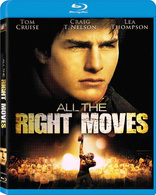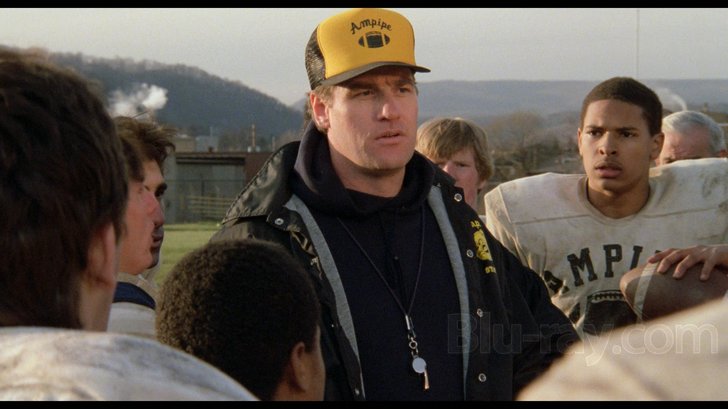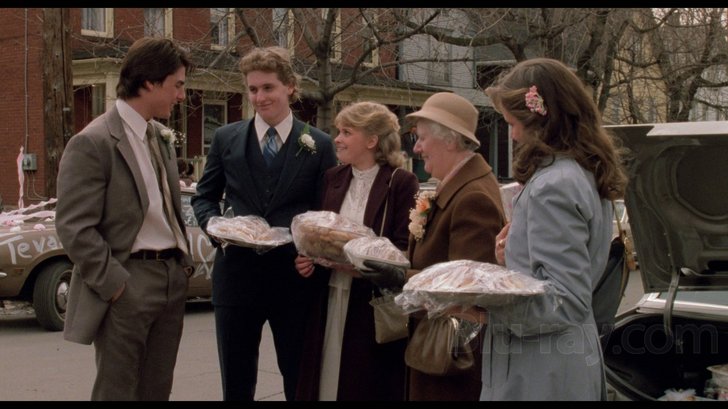All the Right Moves Blu-ray Movie
HomeAll the Right Moves Blu-ray Movie 
20th Century Fox | 1983 | 90 min | Rated R | May 03, 2011
Movie rating
6.1 | / 10 |
Blu-ray rating
| Users | 2.6 | |
| Reviewer | 3.0 | |
| Overall | 2.8 |
Overview
All the Right Moves (1983)
The only way football star Stefan Djordjevic will avoid a life in the blast furnaces of his bleak Pennsylvania hometown is by winning a college scholarship. Even his coach dreams of parlaying a winning team into a college job far away from this graveyard of the American Dream. But it's not long before the two virtually ruin each other's chances for escape and their door to the future starts to close.
Starring: Tom Cruise, Craig T. Nelson, Lea Thompson, Charles Cioffi, Gary GrahamDirector: Michael Chapman
| Romance | Uncertain |
| Sport | Uncertain |
| Coming of age | Uncertain |
| Drama | Uncertain |
Specifications
Video
Video codec: MPEG-4 AVC
Video resolution: 1080p
Aspect ratio: 1.85:1
Original aspect ratio: 1.85:1
Audio
English: DTS-HD Master Audio 5.1
French: Dolby Digital Mono
Spanish: Dolby Digital Mono
English: Dolby Digital Mono
Subtitles
English SDH, Spanish
Discs
25GB Blu-ray Disc
Single disc (1 BD)
Playback
Region free
Review
Rating summary
| Movie | 3.0 | |
| Video | 3.5 | |
| Audio | 3.0 | |
| Extras | 0.5 | |
| Overall | 3.0 |
All the Right Moves Blu-ray Movie Review
The Only Right Move Is Leaving
Reviewed by Michael Reuben July 10, 2011In the same year that Tom Cruise became famous for dancing in his underwear in Risky Business
(1983), he starred in two other films that have been largely forgotten. One of them was All the
Right Moves, which was marketed as a coming-of-age movie about a cocky football player. But
for all its scenes of players in the locker room and on the field, All the Right Moves isn't really a
sports movie, and you can tell by the fact that it doesn't build to the typical climax of a Big
Game. There's a big game all right, but it occurs in the middle of the film. Enough plot
developments flow from its outcome to sustain a whole additional act (at least). If you look past
the familiar genre wrapping and pay attention to the actual events on screen, an entirely different
story emerges, and it isn't about football or growing up, though those events remain integral to
the story. The film is really a snapshot of seismic shifts in the landscape of portions of American
society, something that's much easier to see from the vantage point of today but that
contemporary viewers missed almost entirely. (One review called the film "mushy".)
Today we have other distractions. A viewer in 1983 could watch a Tom Cruise movie without the
baggage that a viewer in 2011 brings to the experience, after Top Gun, Mission Impossible, Baby
Suri and Oprah's couch. In 1983, Cruise was considered someone to watch; the same review that
called All the Right Moves "mushy" referred to its star as "that superb young actor". Now that
he's been everything from a superstar to a South Park punchline, Cruise can't appear in a film
without evoking innumerable associations. This bit of reserve evokes Maverick; that smile
suggests Jerry Maguire; a speech to a crowd recalls Brian Flanagan in Cocktail; stoic intensity
reminds us of Ethan Hunt - and it never stops. One of the interesting effects of a film like All the
Right Moves is observing just how early on the elements of a movie star's persona have already
gelled, and further observing just how much work is required to shed them for a role that is truly
different (like Vincent in Collateral or Frank T.J. Mackey in Magnolia).

Steffen "Steff" Djordjevic (Cruise) is the star defensive back of his high school football team, the Ampipe Bulldogs. The town and school are named for the American Pipe & Steel Company, which has supported most of the town's population for generations. Steff's father (Charles Cioffi) works there, and so does his older brother, Greg (Gary Graham, a regular presence on TV ever since, notably as Sykes on Alien Nation). But Steff wants something different. He has no interest in playing football professionally, but he's willing to trade his skills for an education so that he can become an architect. He evaluates football scholarships based not on the quality of the team but on the calibre of the school's engineering program, a fact he announces openly to one recruiter (Terry O'Quinn).
Steff's friends Salvucci (Paul Carafotes) and Brian (the late Chris Penn) are working the same angles, as are many of their fellow teammates, but none of them have Steff's skills on the field or his brains in the classroom. All of them are acutely aware that their town is a blue collar backwater, an ethnic melange of Italians, Poles and African-Americans (though the inhabitants themselves use more colloquial terms) scorned by the tonier teams that routinely beat them, notably Walnut Heights.
Certainly their coach, Nickerson (Craig T. Nelson) knows his team's poor record. When he isn't teaching typing class - hardly a demanding position - Coach Nickerson spends his time at a blackboard analyzing plays, desperately hoping to score a surprise victory that will impress the search committee at Cal Poly San Luis Obispo, where he's been interviewing. Like his best players, the coach is desperate to get out of Ampipe. His wife (Sandy Faison) can't wait to leave.
Steff's girlfriend, Lisa (Lea Thompson, two years before Back to the Future), doesn't want Steff to leave but doesn't want to hold him back either. That ambivalence is a big part of what causes Lisa to push Steff away when he wants to sleep with her. Later in the film, though, a deeper conflict emerges. Lisa also wants to go to college, in her case to study music, but as she bitterly points out, no recruiters pass through town offering music scholarships. Unlike Steff and his fellow jocks, she really is stuck in Ampipe.
As the Big Game with Walnut Heights approaches, Coach Nickerson drives his players mercilessly. At the game he goes to extremes. Steff confronts him, and Nickerson throws him off the team. Then, after the Nickerson home is vandalized by local hooligans led by one Bosko (James A. Baffico), Nickerson blackballs Steff with every recruiter. With no more hope of a scholarship, it's time to start punching in at the factory.
Except that it isn't. While all the sports, sex and high school escapades have been happening in the foreground, the real story of All the Right Moves has been steadily unfolding everywhere else. The town is dying. The factory is laying off workers by the hundreds, including Steff's brother. The only work that Steff and his brother can find is dismantling former industrial properties to make way for new construction that will not, when it's completed, offer them further employment. The future of America's Rust Belt has arrived, and there's no place in it for the inhabitants of Ampipe. That's why people like Steff and Coach Nickerson (and Lisa) are so eager to get out.
Ultimately, All the Right Moves is a downbeat film. It manages to reach a modestly happy resolution for some of the characters, but not all of them, because there is no happy ending where leaving is the only right move. Not everyone is free to leave, as is demonstrated by the football player who marries his pregnant girlfriend, or, more tragically, the one who turns to armed robbery in a desperate attempt to support his family. And a story set in the environs of Ampipe could only document the changes happening all around, but it couldn't explore what was causing them. That had to wait for a later film set in a different place, where a fellow named Gordon Gekko called the shots.
All the Right Moves Blu-ray Movie, Video Quality 

A distinguished director of photography, director Chapman chose Dutch DP Jan de Bont to shoot
his directorial debut. De Bont would go on to become one of the late 20th Century's most visible
cinematographers, giving distinctive looks to Die Hard, Black
Rain, The Hunt for
Red October and Basic Instinct, among
others, before becoming a director in his own right with Speed. For All
the Right Moves, de Bont provided a low-key naturalistic look similar to Chapman's own
signature style in such urban films as Hardcore, The Wanderers, the 1978 remake of Invasion of
the Body Snatchers, much of Taxi Driver and later The Fugitive and Quick Change. The film was
shot on location in Johnstown, PA, which is located in the heart of Pennsylvania manufacturing
territory.
The 1080p AVC-encoded Blu-ray effectively reproduces de Bont's down-and-dirty images.
These are real schools, homes and factories, and they haven't been spruced up or lit to look like
anything other than what they are. Though colors are generally muted (with an occasional
exception, such as the team's bright yellow uniforms), fleshtones look natural. While there is
some degree of black crush in darker areas of night scenes, detail remains sufficiently well
delineated that fine detail in clothing patterns or on faces in crowds is always visible. Film grain
is evident but mild, except during the opening and closing title sequences, where the optical
printing process that was standard for the era has accentuated it and, in some title frames, the
grain appears to freeze (or "hang") for a moment. This usually indicates a less-than-successful
effort at grain reduction, but it's transient and minor. However, the detail in both the opening and
closing title sequence is significantly reduced and the image is much softer; these sequences
should not be taken as representative of the transfer as a whole. (I have included a screenshot as
an example.)
All the Right Moves Blu-ray Movie, Audio Quality 

The original mono soundtrack has been remixed for 5.1 and is offered in DTS lossless, but there
is virtually no surround presence. The film's dialogue and sound effects remain in the front
soundstage, primarily in the center, with the musical selections spreading to the left and right.
Original scoring is credited to David Richard Campbell, but the primary musical accompaniment
are pop songs assembled (and often written or co-written) by music supervisor Bruce Arthur. The
artists include such Eighties stand-bys as Jennifer Warnes, Tony Orlando, Junior and Stephanie
Mills.
The 5.1 remix lends extra punch to the music, but the dialogue doesn't always fare as well. It's
occasionally rendered hollow and artificial-sounding, its origins in an ADR studio laid bare by
the more revealing fidelity of a discrete mix and lossless delivery.
All the Right Moves Blu-ray Movie, Special Features and Extras 

- Theatrical Trailer (SD; 1.85:1, enhanced; 2:24): A routine product of the marketing department with emphasis on the film's sports elements.
- Spanish Theatrical Trailer (SD; 1.85:1, non-enhanced; 2:24): The same trailer with the voiceover in Spanish.
All the Right Moves Blu-ray Movie, Overall Score and Recommendation 

All the Right Moves is a fascinating time capsule of elements both expected and unexpected. The
expected includes a look at early work by Tom Cruise and Lea Thompson at the outset of their
careers. The unexpected is an early and prescient look at social and economic forces that would
ultimately define much of America in the last quarter of the 20th Century, captured with a raw
immediacy while they were still in motion. The Blu-ray's technical quality is acceptable, though
not perfect. A major disappointment is the lack of any input from director Chapman, who retired
after serving as cinematographer for Bridge to Terabithia and from whom it would be worth
obtaining as much insight as he is willing to share while he is still with us. Recommended for
those interested in any of the subjects discussed above. If you're looking for a rousing sports
film, you'll be disappointed.
Similar titles
Similar titles you might also like

Youngblood
Special Edition
1986

Jerry Maguire
1996

Love & Basketball
2000

For Love of the Game
1999

Vision Quest
Warner Archive Collection
1985

Blue Crush
2002

Pat and Mike
Warner Archive Collection
1952

The Legend of Bagger Vance
2000

Bull Durham
1988

Blue Crush 2
2011

Friday Night Lights: The Complete Series
2006-2011

The Cutting Edge: Going for the Gold
2006

North Shore
1987

Tin Cup
Warner Archive Collection
1996

Not Easily Broken
2009

Heaven Can Wait
1978

That's My Man
1947

Against the Ropes
2004

Crazy/Beautiful
2001

Coach Carter
2005